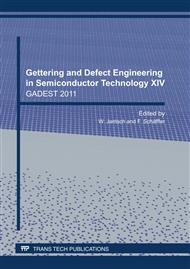p.25
p.31
p.35
p.43
p.50
p.56
p.61
p.67
p.72
Acceptor Deactivation in Silicon Nanowires Analyzed by Scanning Spreading Resistance Microscopy
Abstract:
Vertical p-type Si nanowires (NWs) "in-situ" doped during growth or "ex-situ" by B ion implantation are investigated regarding their acceptor activation. Due to the much higher surface to volume ratio of the NW in comparison to bulk material the surface effect plays an important role in determining the doping behaviour. Dopant segregation and fixed positive charges at the Si/SiO2 interface result in an acceptor deactivation. The B concentration introduced into the NW has to balance the deactivation effects in order to reach the intended electrical parameters. Scanning spreading resistance microscopy is used for the electrical characterization of the NWs. This analysis method provides images of the local resistivity of NW cross sections. Resistivity data are converted into acceptor concentration values by calibration. The study demonstrates that scanning spreading resistance microscopy is a suitable analysis method capable to spatially and electrically resolve Si NWs in the nanometer-scale. The NW resistivity is found to be size dependent and shows a significant increase as the NW is below 25 nm in diameter. The obtained data can be explained by a core-shell model with a highly conductive NW core and low conductive shell.
Info:
Periodical:
Pages:
50-55
Citation:
Online since:
August 2011
Price:
Сopyright:
© 2011 Trans Tech Publications Ltd. All Rights Reserved
Share:
Citation:


